ZHCSGX5 October 2017 ADS54J64
PRODUCTION DATA.
- 1 特性
- 2 应用
- 3 说明
- 4 修订历史记录
- 5 Pin Configuration and Functions
-
6 Specifications
- 6.1 Absolute Maximum Ratings
- 6.2 ESD Ratings
- 6.3 Recommended Operating Conditions
- 6.4 Thermal Information
- 6.5 Electrical Characteristics
- 6.6 AC Performance
- 6.7 Digital Characteristics
- 6.8 Timing Characteristics
- 6.9 Typical Characteristics: DDC Bypass Mode
- 6.10 Typical Characteristics: Mode 2
- 6.11 Typical Characteristics: Mode 0
- 6.12 Typical Characteristics: Dual ADC Mode
-
7 Detailed Description
- 7.1 Overview
- 7.2 Functional Block Diagram
- 7.3 Feature Description
- 7.4
Device Functional Modes
- 7.4.1
Digital Functions
- 7.4.1.1 Numerically Controlled Oscillators (NCOs) and Mixers
- 7.4.1.2 Decimation Filter
- 7.4.1.3 Mode 0: Decimate-by-4 With IQ Outputs and fS / 4 Mixer
- 7.4.1.4 Mode 1: Decimate-by-4 With IQ Outputs and 16-Bit NCO
- 7.4.1.5 Mode 2: Decimate-by-4 With Real Output
- 7.4.1.6 Mode 3: Decimate-by-2 Real Output With Frequency Shift
- 7.4.1.7 Mode 4: Decimate-by-4 With Real Output
- 7.4.1.8 Mode 6: Decimate-by-4 With IQ Outputs for Up to 110 MHz of IQ Bandwidth
- 7.4.1.9 Mode 7: Decimate-by-4 With Real Output and Zero Stuffing
- 7.4.1.10 Mode 8: DDC Bypass Mode
- 7.4.1.11 Averaging Mode
- 7.4.1.12 Overrange Indication
- 7.4.1
Digital Functions
- 7.5 Programming
- 7.6
Register Maps
- 7.6.1
Register Map
- 7.6.1.1
Register Description
- 7.6.1.1.1
GLOBAL Page Register Description
- 7.6.1.1.1.1 Register 00h (address = 00h) [reset = 0h], GLOBAL Page
- 7.6.1.1.1.2 Register 04h (address = 04h) [reset = 0h], GLOBAL Page
- 7.6.1.1.1.3 Register 11h (address = 11h) [reset = 0h], GLOBAL Page
- 7.6.1.1.1.4 Register 12h (address = 12h) [reset = 0h], GLOBAL Page
- 7.6.1.1.1.5 Register 13h (address = 13h) [reset = 0h], GLOBAL Page
- 7.6.1.1.2
DIGTOP Page Register Description
- 7.6.1.1.2.1 Register 64h (address = 64h) [reset = 0h], DIGTOP Page
- 7.6.1.1.2.2 Register 8Dh (address = 8Dh) [reset = 0h], DIGTOP Page
- 7.6.1.1.2.3 Register 8Eh (address = 8Eh) [reset = 0h], DIGTOP Page
- 7.6.1.1.2.4 Register 8Fh (address = 8Fh) [reset = 0h], DIGTOP Page
- 7.6.1.1.2.5 Register 90h (address = 90h) [reset = 0h], DIGTOP Page
- 7.6.1.1.2.6 Register 91h (address = 91h) [reset = 0h], DIGTOP Page
- 7.6.1.1.2.7 Register A5h (address = A5h) [reset = 0h], DIGTOP Page
- 7.6.1.1.2.8 Register A6h (address = A6h) [reset = 0h], DIGTOP Page
- 7.6.1.1.2.9 Register ABh (address = ABh) [reset = 0h], DIGTOP Page
- 7.6.1.1.2.10 Register ACh (address = ACh) [reset = 0h], DIGTOP Page
- 7.6.1.1.2.11 Register ADh (address = ADh) [reset = 0h], DIGTOP Page
- 7.6.1.1.2.12 Register AEh (address = AEh) [reset = 0h], DIGTOP Page
- 7.6.1.1.2.13 Register B7h (address = B7h) [reset = 0h], DIGTOP Page
- 7.6.1.1.2.14 Register 8Ch (address = 8Ch) [reset = 0h], DIGTOP Page
- 7.6.1.1.3
ANALOG Page Register Description
- 7.6.1.1.3.1 Register 6Ah (address = 6Ah) [reset = 0h], ANALOG Page
- 7.6.1.1.3.2 Register 6Fh (address = 6Fh) [reset = 0h], ANALOG Page
- 7.6.1.1.3.3 Register 71h (address = 71h) [reset = 0h], ANALOG Page
- 7.6.1.1.3.4 Register 72h (address = 72h) [reset = 0h], ANALOG Page
- 7.6.1.1.3.5 Register 93h (address = 93h) [reset = 0h], ANALOG Page
- 7.6.1.1.3.6 Register 94h (address = 94h) [reset = 0h], ANALOG Page
- 7.6.1.1.3.7 Register 9Bh (address = 9Bh) [reset = 0h], ANALOG Page
- 7.6.1.1.3.8 Register 9Dh (address = 9Dh) [reset = 0h], ANALOG Page
- 7.6.1.1.3.9 Register 9Eh (address = 9Eh) [reset = 0h], ANALOG Page
- 7.6.1.1.3.10 Register 9Fh (address = 9Fh) [reset = 0h], ANALOG Page
- 7.6.1.1.3.11 Register AFh (address = AFh) [reset = 0h], ANALOG Page
- 7.6.1.1.4
SERDES_XX Page Register Description
- 7.6.1.1.4.1 Register 20h (address = 20h) [reset = 0h], SERDES_XX Page
- 7.6.1.1.4.2 Register 21h (address = 21h) [reset = 0h], SERDES_XX Page
- 7.6.1.1.4.3 Register 22h (address = 22h) [reset = 0h], SERDES_XX Page
- 7.6.1.1.4.4 Register 23h (address = 23h) [reset = 0h], SERDES_XX Page
- 7.6.1.1.4.5 Register 25h (address = 25h) [reset = 0h], SERDES_XX Page
- 7.6.1.1.4.6 Register 26h (address = 26h) [reset = 0h], SERDES_XX Page
- 7.6.1.1.4.7 Register 28h (address = 28h) [reset = 0h], SERDES_XX Page
- 7.6.1.1.4.8 Register 2Dh (address = 2Dh) [reset = 0h], SERDES_XX Page
- 7.6.1.1.4.9 Register 36h (address = 36h) [reset = 0h], SERDES_XX Page
- 7.6.1.1.4.10 Register 41h (address = 41h) [reset = 0h], SERDES_XX Page
- 7.6.1.1.4.11 Register 42h (address = 42h) [reset = 0h], SERDES_XX Page
- 7.6.1.1.5
CHX Page Register Description
- 7.6.1.1.5.1 Register 26h (address = 26h) [reset = 0h], CHX Page
- 7.6.1.1.5.2 Register 27h (address = 27h) [reset = 0h], CHX Page
- 7.6.1.1.5.3 Register 2Dh (address = 2Dh) [reset = 0h], CHX Page
- 7.6.1.1.5.4 Register 78h (address = 78h) [reset = 0h], CHX Page
- 7.6.1.1.5.5 Register 7Ah (address = 7Ah) [reset = 0h], CHX Page
- 7.6.1.1.5.6 Register 7Bh (address = 7Bh) [reset = 0h], CHX Page
- 7.6.1.1.5.7 Register 7Eh (address = 7Eh) [reset = 3h], CHX Page
- 7.6.1.1.6
ADCXX Page Register Description
- 7.6.1.1.6.1 Register 07h (address = 07h) [reset = FFh], ADCXX Page
- 7.6.1.1.6.2 Register 08h (address = 08h) [reset = 0h], ADCXX Page
- 7.6.1.1.6.3 Register D5h (address = D5h) [reset = 0h], ADCXX Page
- 7.6.1.1.6.4 Register 2Ah (address = 2Ah) [reset = 0h], ADCXX Page
- 7.6.1.1.6.5 Register CFh (address = CFh) [reset = 0h], ADCXX Page
- 7.6.1.1.1
GLOBAL Page Register Description
- 7.6.1.1
Register Description
- 7.6.1
Register Map
- 8 Application and Implementation
- 9 Power Supply Recommendations
- 10Layout
- 11器件和文档支持
- 12机械、封装和可订购信息
6 Specifications
6.1 Absolute Maximum Ratings
over operating free-air temperature range (unless otherwise noted)(1)| MIN | MAX | UNIT | ||
|---|---|---|---|---|
| Supply voltage | AVDD19 | –0.3 | 2.1 | V |
| AVDD | –0.3 | 1.4 | ||
| DVDD | –0.3 | 1.4 | ||
| Voltage between AGND and DGND | –0.3 | 0.3 | V | |
| Voltage applied to input pins | INAP, INBP, INAM, INBM, INCP, INDP, INCM, INDM | –0.3 | 2.1 | V |
| CLKINP, CLKINM | –0.3 | AVDD + 0.3 | ||
| SYSREFP, SYSREFM | –0.3 | 1.9 | ||
| SCLK, SEN, SDIN, RESET, SYNCbABP, SYNCbABM, SYNCbCDP, SYNCbCDM, PDN, TRIGAB, TRIGCD | –0.2 | AVDD19 + 0.3 | ||
| Storage temperature, Tstg | –65 | 150 | °C | |
(1) Stresses beyond those listed under Absolute Maximum Ratings may cause permanent damage to the device. These are stress ratings only, which do not imply functional operation of the device at these or any other conditions beyond those indicated under Recommended Operating Conditions. Exposure to absolute-maximum-rated conditions for extended periods may affect device reliability.
6.2 ESD Ratings
| VALUE | UNIT | |||
|---|---|---|---|---|
| V(ESD) | Electrostatic discharge | Human-body model (HBM), per ANSI/ESDA/JEDEC JS-001(1) | ±2000 | V |
(1) JEDEC document JEP155 states that 500-V HBM allows safe manufacturing with a standard ESD control process.
6.3 Recommended Operating Conditions
over operating free-air temperature range (unless otherwise noted)| MIN | NOM | MAX | UNIT | |||
|---|---|---|---|---|---|---|
| Supply voltage range | AVDD19 | 1.8 | 1.9 | 2 | V | |
| AVDD | 1.1 | 1.15 | 1.2 | |||
| DVDD | 1.1 | 1.15 | 1.2 | |||
| Analog inputs | Differential input voltage range | 1.1 | VPP | |||
| Input common-mode voltage (VCM) | 1.3 | V | ||||
| Clock inputs | Input clock frequency, device clock frequency | 400 | 1000 | MHz | ||
| Input clock amplitude differential (VCLKP – VCLKM) |
Sine wave, ac-coupled | 1.5 | VPP | |||
| LVPECL, ac-coupled | 1.6 | |||||
| LVDS, ac-coupled | 0.7 | |||||
| Input device clock duty cycle, default after reset | 45% | 50% | 55% | |||
| Temperature | Operating free-air, TA | –40 | 100(2) | ºC | ||
| Operating junction, TJ | 105(1) | |||||
| Specified maximum, measured at the device footprint thermal pad on the printed circuit board, TP-MAX | 104.5(1) | |||||
(1) Prolonged use above this junction temperature can increase the device failure-in-time (FIT) rate.
(1) The recommended maximum temperature at the PCB footprint thermal pad assumes the junction-to-package bottom thermal resistance, RθJC(bot) = 0.2°C/W, the thermal resistance of the device thermal pad connection to the PCB footprint is negligible, and the device power consumption is 2.5 W.
(2) Assumes system thermal design meets the TJ specification.
6.4 Thermal Information
| THERMAL METRIC(1) | ADS54J64 | UNIT | |
|---|---|---|---|
| RMP (VQFNP) | |||
| 72 PINS | |||
| RθJA | Junction-to-ambient thermal resistance (1) | 22.3 | °C/W |
| RθJC(top) | Junction-to-case (top) thermal resistance (2) | 5.1 | °C/W |
| RθJB | Junction-to-board thermal resistance (2) | 2.4 | °C/W |
| ψJT | Junction-to-top characterization parameter (3) | 0.1 | °C/W |
| ψJB | Junction-to-board characterization parameter (4) | 2.3 | °C/W |
| RθJC(bot) | Junction-to-case (bottom) thermal resistance (5) | 0.2 | °C/W |
(1) For more information about traditional and new thermal metrics, see the Semiconductor and IC Package Thermal Metrics application report.
(1) The junction-to-ambient thermal resistance under natural convection is obtained in a simulation on a JEDEC-standard, high-K board, as specified in JESD51-7, in an environment described in JESD51-2a.
(2) The junction-to-case (top) thermal resistance is obtained by simulating a cold plate test on the package top. No specific JEDEC-standard test exists, but a close description can be found in the ANSI SEMI standard G30-88.
(3) The junction-to-board thermal resistance is obtained by simulating in an environment with a ring cold plate fixture to control the PCB temperature, as described in JESD51-8.
(4) The junction-to-top characterization parameter, ψJT, estimates the junction temperature of a device in a real system and is extracted from the simulation data for obtaining θJA, using a procedure described in JESD51-2a (sections 6 and 7).
(5) The junction-to-board characterization parameter, ψJB, estimates the junction temperature of a device in a real system and is extracted from the simulation data for obtaining θJA , using a procedure described in JESD51-2a (sections 6 and 7).
6.5 Electrical Characteristics
typical values are at TA = 25°C, full temperature range is from TMIN = –40°C to TMAX = +100°C, input clock frequency = 1 GHz, 50% clock duty cycle, output sample rate = 500 MSPS, AVDD19 = 1.9 V, AVDD = DVDD = 1.15 V, –1-dBFS differential input, and fIN = 190 MHz (unless otherwise noted)| PARAMETER | TEST CONDITIONS | MIN | TYP | MAX | UNIT | ||
|---|---|---|---|---|---|---|---|
| GENERAL | |||||||
| ADC sampling rate | 1 | GSPS | |||||
| Resolution | 14 | Bits | |||||
| POWER SUPPLY | |||||||
| AVDD19 | 1.9-V analog supply | 1.85 | 1.9 | 1.95 | V | ||
| AVDD | 1.15-V analog supply | 1.1 | 1.15 | 1.2 | V | ||
| DVDD | 1.15-V digital supply | 1.1 | 1.15 | 1.2 | V | ||
| IAVDD19 | 1.9-V analog supply current | 100-MHz, full-scale input on all four channels | 618 | mA | |||
| IAVDD | 1.15-V analog supply current | 100-MHz, full-scale input on all four channels | 415 | mA | |||
| IDVDD | 1.15-V digital supply current | DDC bypass mode (mode 8), 100-MHz, full-scale input on all four channels | 629 | mA | |||
| Mode 3, 100-MHz, full-scale input on all four channels | 730 | ||||||
| Mode 0 and 2, 100-MHz, full-scale input on all four channels | 674 | ||||||
| Mode 1, 4, 6, and 7, 100-MHz, full-scale input on all four channels | 703 | ||||||
| PDIS | Total power dissipation | DDC bypass mode (mode 8), 100-MHz, full-scale input on all four channels | 2.37 | W | |||
| Mode 3, 100-MHz, full-scale input on all four channels | 2.49 | ||||||
| Mode 0 and 2, 100-MHz, full-scale input on all four channels | 2.42 | ||||||
| Mode 1, 4, 6, and 7, 100-MHz, full-scale input on all four channels | 2.46 | ||||||
| Global power-down power dissipation | Full-scale input on all four channels | 120 | mW | ||||
| ANALOG INPUTS | |||||||
| Differential input full-scale voltage | 1.1 | VPP | |||||
| Input common-mode voltage | 1.3 | V | |||||
| Differential input resistance | At fIN = dc | 4 | kΩ | ||||
| Differential input capacitance | 2.5 | pF | |||||
| Analog input bandwidth (3 dB) | 1000 | MHz | |||||
| ISOLATION | |||||||
| Crosstalk(1) isolation between near channels (channels A and B are near to each other, channels C and D are near to each other) |
fIN = 10 MHz | 75 | dBFS | ||||
| fIN = 100 MHz | 75 | ||||||
| fIN = 170 MHz | 74 | ||||||
| fIN = 270 MHz | 72 | ||||||
| fIN = 370 MHz | 71 | ||||||
| fIN = 470 MHz | 70 | ||||||
| Crosstalk(1) isolation between far channels (channels A and B are far from channels C and D) |
fIN = 10 MHz | 110 | dBFS | ||||
| fIN = 100 MHz | 110 | ||||||
| fIN = 170 MHz | 110 | ||||||
| fIN = 270 MHz | 110 | ||||||
| fIN = 370 MHz | 110 | ||||||
| fIN = 470 MHz | 110 | ||||||
| CLOCK INPUT | |||||||
| Internal clock biasing | CLKINP and CLKINM pins are connected to the internal biasing voltage through a 5-kΩ resistor | 0.7 | V | ||||
(1) Crosstalk is measured with a –1-dBFS input signal on the aggressor channel and no input on the victim channel.
6.6 AC Performance
typical values are at TA = 25°C, full temperature range is from TMIN = –40°C to TMAX = +100°C, input clock frequency = 1 GHz, 50% clock duty cycle, output sample rate = 500 MSPS, AVDD19 = 1.9 V, AVDD = DVDD = 1.15 V, –1-dBFS differential input, and fIN = 190 MHz (unless otherwise noted)| PARAMETER | TEST CONDITIONS | MIN | TYP | MAX | MIN | TYP | MAX | UNIT | |
|---|---|---|---|---|---|---|---|---|---|
| DDC BYPASS MODE | DECIMATE-BY-4 (DDC Mode 2) |
||||||||
| SNR | Signal-to-noise ratio | fIN = 10 MHz, AIN = –1 dBFS | 69.9 | 72.2 | dBFS | ||||
| fIN = 70 MHz, AIN = –1 dBFS | 69.6 | 71.8 | |||||||
| fIN = 190 MHz, AIN = –1 dBFS | 69.2 | 71.8 | |||||||
| fIN = 190 MHz, AIN = –3 dBFS | 66.5 | 69.6 | 71 | ||||||
| fIN = 300 MHz, AIN = –3 dBFS | 69.3 | 71.7 | |||||||
| fIN = 370 MHz, AIN = –3 dBFS | 68.7 | 71.3 | |||||||
| fIN = 470 MHz, AIN = –3 dBFS | 68.4 | 69.8 | |||||||
| NSD | Noise spectral density | fIN = 10 MHz, AIN = –1 dBFS | –153.9 | –153.2 | dBFS/Hz | ||||
| fIN = 70 MHz, AIN = –1 dBFS | –153.6 | –152.8 | |||||||
| fIN = 190 MHz, AIN = –1 dBFS | –153.2 | –152.7 | |||||||
| fIN = 190 MHz, AIN = –3 dBFS | –150.5 | –153.6 | –153.2 | ||||||
| fIN = 300 MHz, AIN = –3 dBFS | –152.8 | –152.7 | |||||||
| fIN = 370 MHz, AIN = –3 dBFS | –152.5 | –152.2 | |||||||
| fIN = 470 MHz, AIN = –3 dBFS | –151.5 | –151 | |||||||
| SFDR(1) | Spurious-free dynamic range | fIN = 10 MHz, AIN = –1 dBFS | 83 | 83 | dBc | ||||
| fIN = 70 MHz, AIN = –1 dBFS | 81 | 100 | |||||||
| fIN = 190 MHz, AIN = –1 dBFS | 87 | 100 | |||||||
| fIN = 190 MHz, AIN = –3 dBFS | 78 | 88 | 98 | ||||||
| fIN = 300 MHz, AIN = –3 dBFS | 79 | 98 | |||||||
| fIN = 370 MHz, AIN = –3 dBFS, input clock frequency = 983.04 MHz |
82 | 70 | |||||||
| fIN = 470 MHz, AIN = –3 dBFS | 78 | 76 | |||||||
| SINAD | Signal-to-noise and distortion ratio | fIN = 10 MHz, AIN = –1 dBFS | 68.5 | 70.6 | dBFS | ||||
| fIN = 70 MHz, AIN = –1 dBFS | 68.5 | 70.6 | |||||||
| fIN = 190 MHz, AIN = –1 dBFS | 68.2 | 72.2 | |||||||
| fIN = 190 MHz, AIN = –3 dBFS | 68.5 | 73 | |||||||
| fIN = 300 MHz, AIN = –3 dBFS | 68.9 | 72.3 | |||||||
| fIN = 370 MHz, AIN = –3 dBFS | 68 | 68.2 | |||||||
| fIN = 470 MHz, AIN = –3 dBFS | 68 | 69 | |||||||
| HD2(1) | Second-order harmonic distortion | fIN = 10 MHz, AIN = –1 dBFS | –83 | –90 | dBc | ||||
| fIN = 70 MHz, AIN = –1 dBFS | –82 | –100 | |||||||
| fIN = 190 MHz, AIN = –1 dBFS | –85 | –98 | |||||||
| fIN = 190 MHz, AIN = –3 dBFS | –78 | –86 | –100 | ||||||
| fIN = 300 MHz, AIN = –3 dBFS | –82 | –100 | |||||||
| fIN = 370 MHz, AIN = –3 dBFS input clock frequency = 983.04 MHz |
–82 | –69 | |||||||
| fIN = 470 MHz, AIN = –3 dBFS | –100 | –94 | |||||||
| HD3(1) | Third-order harmonic distortion | fIN = 10 MHz, AIN = –1 dBFS | –83 | –85 | dBc | ||||
| fIN = 70 MHz, AIN = –1 dBFS | –81 | –100 | |||||||
| fIN = 190 MHz, AIN = –1 dBFS | –92 | –100 | |||||||
| fIN = 190 MHz, AIN = –3 dBFS | –78 | –92 | –100 | ||||||
| fIN = 300 MHz, AIN = –3 dBFS | –90 | –100 | |||||||
| fIN = 370 MHz, AIN = –3 dBFS | –90 | –100 | |||||||
| fIN = 470 MHz, AIN = –3 dBFS | –80 | –79 | |||||||
| Non HD2, HD3 |
Spurious-free dynamic range (excluding HD2, HD3) | fIN = 10 MHz, AIN = –1 dBFS | 95 | –100 | dBFS | ||||
| fIN = 70 MHz, AIN = –1 dBFS | 95 | –92 | |||||||
| fIN = 190 MHz, AIN = –1 dBFS | 95 | –100 | |||||||
| fIN = 190 MHz, AIN = –3 dBFS | 87 | 95 | –98 | ||||||
| fIN = 300 MHz, AIN = –3 dBFS | 95 | –100 | |||||||
| fIN = 370 MHz, AIN = –3 dBFS | 95 | –100 | |||||||
| fIN = 470 MHz, AIN = –3 dBFS | 93 | –100 | |||||||
| THD(1) | Total harmonic distortion | fIN = 10 MHz, AIN = –1 dBFS | –81 | –83 | dBc | ||||
| fIN = 70 MHz, AIN = –1 dBFS | –79 | –100 | |||||||
| fIN = 190 MHz, AIN = –1 dBFS | –83 | –100 | |||||||
| fIN = 190 MHz, AIN = –3 dBFS | –85 | –100 | |||||||
| fIN = 300 MHz, AIN = –3 dBFS | –81 | –100 | |||||||
| fIN = 370 MHz, AIN = –3 dBFS | –76 | –68 | |||||||
| fIN = 470 MHz, AIN = –3 dBFS | –82 | –80 | |||||||
| IMD3 | Two-tone, third-order intermodulation distortion | f1 = 185 MHz, f2 = 190 MHz, AIN = –10 dBFS |
–90 | –87 | dBFS | ||||
| f1 = 365 MHz, f2 = 370 MHz, AIN = –10 dBFS |
–90 | –94 | |||||||
| f1 = 465 MHz, f2 = 470 MHz, AIN = –10 dBFS |
–85 | –85 | |||||||
(1) Harmonic distortion performance can be significantly improved by using the frequency planning explained in the Frequency Planning section.
6.7 Digital Characteristics
typical values are at TA = 25°C, full temperature range is from TMIN = –40°C to TMAX = +100°C, input clock frequency = 1 GHz, 50% clock duty cycle, output sample rate = 500 MSPS, AVDD19 = 1.9 V, AVDD = DVDD = 1.15 V, –1-dBFS differential input, and fIN = 190 MHz (unless otherwise noted)| PARAMETER | TEST CONDITIONS | MIN | TYP | MAX | UNIT | |
|---|---|---|---|---|---|---|
| DIGITAL INPUTS (RESET, SCLK, SEN, SDIN, PDN, TRIGAB, TRIGCD)(1) | ||||||
| VIH | High-level input voltage | All digital inputs support 1.2-V and 1.8-V logic levels | 0.8 | V | ||
| VIL | Low-level input voltage | All digital inputs support 1.2-V and 1.8-V logic levels | 0.4 | V | ||
| IIH | High-level input current | SEN | 0 | µA | ||
| RESET, SCLK, SDIN, PDN, TRIGAB, TRIGCD | 50 | |||||
| IIL | Low-level input current | SEN | 50 | µA | ||
| RESET, SCLK, SDIN, PDN, TRIGAB, TRIGCD | 0 | |||||
| Input capacitance | 4 | pF | ||||
| DIGITAL INPUTS | ||||||
| VD | Differential input voltage | SYSREFP, SYSREFM | 0.35 | 0.45 | 0.55 | V |
| SYNCbABM, SYNCbABP, SYNCbCDM, SYNCbCDP | 0.35 | 0.45 | 0.8 | |||
| V(CM_DIG) | Common-mode voltage for SYSREF | SYSREFP, SYSREFM | 0.9 | 1.2 | 1.4 | V |
| SYNCbABM, SYNCbABP, SYNCbCDM, SYNCbCDP | 0.9 | 1.2 | 1.4 | |||
| DIGITAL OUTPUTS (SDOUT, TRDYAB, TRDYCD) | ||||||
| VOH | High-level output voltage | 100-µA current | AVDD19 – 0.2 | V | ||
| VOL | Low-level output voltage | 100-µA current | 0.2 | V | ||
| DIGITAL OUTPUTS (JESD204B Interface: DxP, DxM)(2) | ||||||
| VOD | Output differential voltage | With default swing setting | 700 | mVPP | ||
| VOC | Output common-mode voltage | 450 | mV | |||
| Transmitter short-circuit current | Transmitter pins shorted to any voltage between –0.25 V and 1.45 V | –100 | 100 | mA | ||
| zos | Single-ended output impedance | 50 | Ω | |||
| Output capacitance | Output capacitance inside the device, from either output to ground |
2 | pF | |||
(1) The RESET, SCLK, SDIN, and PDN pins have a 10-kΩ (typical) internal pulldown resistor to ground, and the SEN pin has a 10-kΩ (typical) pullup resistor to DVDD.
(2) 50-Ω, single-ended external termination to DVDD.
6.8 Timing Characteristics
typical values are at TA = 25°C, full temperature range is from TMIN = –40°C to TMAX = +100°C, input clock frequency = 1 GHz, 50% clock duty cycle, output sample rate = 500 MSPS, AVDD19 = 1.9 V, AVDD = DVDD = 1.15 V, –1-dBFS differential input, and fIN = 190 MHz (unless otherwise noted)| MIN | TYP | MAX | UNITS | |||
|---|---|---|---|---|---|---|
| SAMPLE TIMING CHARACTERISTICS | ||||||
| Aperture delay | 0.55 | 0.92 | ns | |||
| Aperture delay matching between two channels on the same device | ±100 | ps | ||||
| Aperture delay matching between two devices at the same temperature and supply voltage | ±100 | ps | ||||
| Aperture jitter | 100 | fS rms | ||||
| Wake-up time | Global power-down | 10 | ms | |||
| Pin power-down (fast power-down) | 5 | µs | ||||
| Data latency: ADC sample to digital output | DDC bypass mode | 116 | Input clock cycles | |||
| DDC mode 0 | 204 | |||||
| tSU_SYSREF | Setup time for SYSREF, referenced to input clock rising edge | 350 | 900 | ps | ||
| tH_SYSREF | Hold time for SYSREF, referenced to input clock rising edge | 100 | ps | |||
| JESD OUTPUT INTERFACE TIMING CHARACTERISTICS | ||||||
| Unit interval | 100 | ps | ||||
| Serial output data rate | 10 | Gbps | ||||
| Total jitter for BER of 1E-15 and lane rate = 10 Gbps | 24 | ps | ||||
| Random jitter for BER of 1E-15 and lane rate = 10 Gbps | 0.95 | ps rms | ||||
| Deterministic jitter for BER of 1E-15 and lane rate = 10 Gbps | 8.8 | ps, pk-pk | ||||
| tR, tF | Data rise time, data fall time: rise and fall times measured from 20% to 80%, differential output waveform, 2.5 Gbps ≤ bit rate ≤ 10 Gbps | 35 | ps | |||
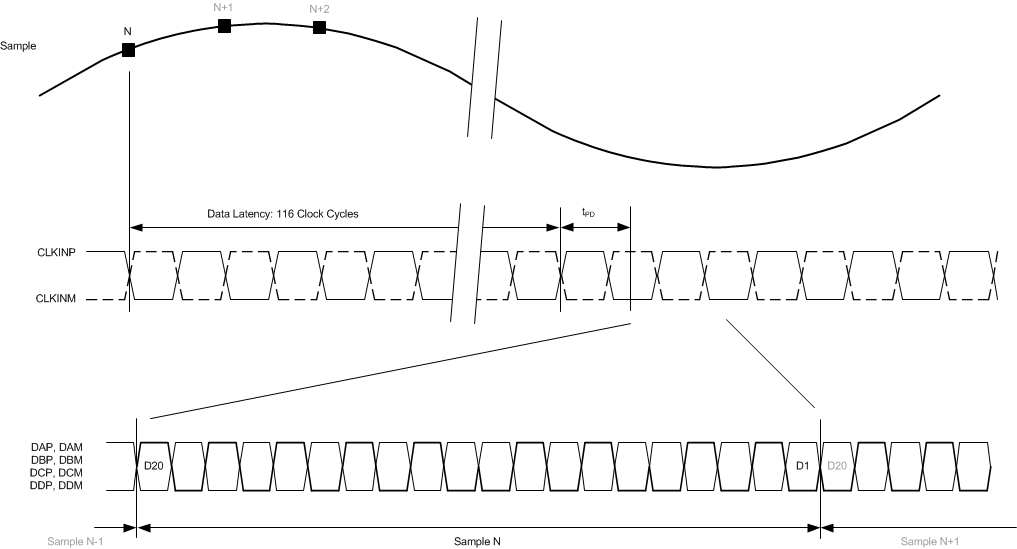 Figure 1. Latency Timing Diagram in DDC Bypass Mode
Figure 1. Latency Timing Diagram in DDC Bypass Mode
6.9 Typical Characteristics: DDC Bypass Mode
typical values are at TA = 25°C, full temperature range is from TMIN = –40°C to TMAX = +100°C, device sampling frequency = 1 GSPS, 50% clock duty cycle, output sample rate = 500 MSPS, AVDD19 = 1.9 V, AVDD = DVDD = 1.15 V, –1-dBFS differential input, and fIN = 190 MHz (unless otherwise noted)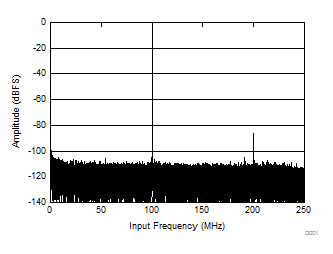
| fIN = 100 MHz, AIN = –1 dBFS, SNR = 69.57 dBFS, SFDR = 85.23 dBc, SFDR = 102.09 dBc (non 23) |
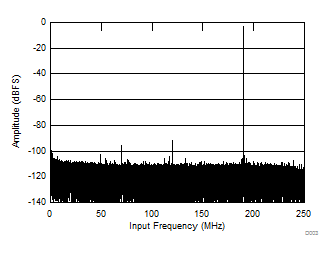
| fIN = 190 MHz, AIN = –3 dBFS, SNR = 69.60 dBFS, SFDR = 88.45 dBc, SFDR = 99.78 dBc (non 23) |
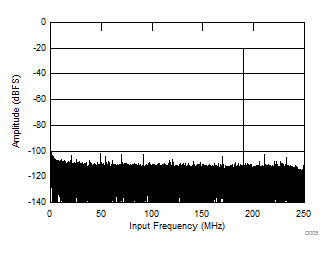
| fIN = 190 MHz, AIN = –20 dBFS, SNR = 70.23 dBFS, SFDR = 81.71 dBc, SFDR = 81.71 dBc (non 23) |
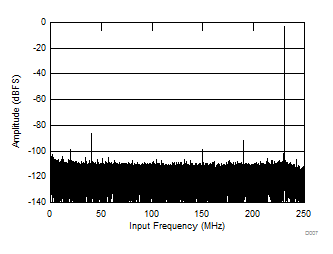
| fIN = 270 MHz, AIN = –3 dBFS, SNR = 69.27 dBFS, SFDR = 82.98 dBc, SFDR = 95.4 dBc (non 23) |
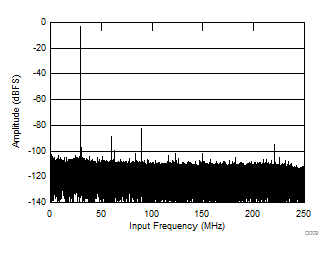
| fIN = 470 MHz, AIN = –3 dBFS, SNR = 68.21 dBFS, SFDR = 79.85 dBc, SFDR = 99.12 dBc (non 23) |
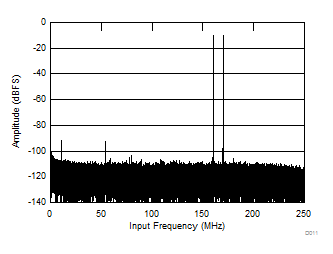
| fIN1 = 160 MHz, fIN2 = 170 MHz, IMD = 103.44 dBFS, each tone at –10 dBFS |
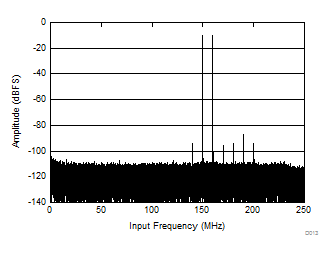
| fIN1 = 340 MHz, fIN2 = 350 MHz, IMD = 95.08 dBFS, each tone at –10 dBFS |
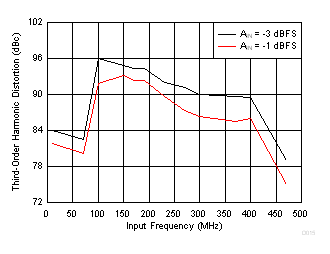
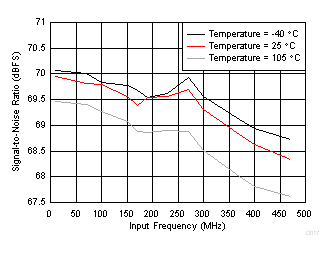
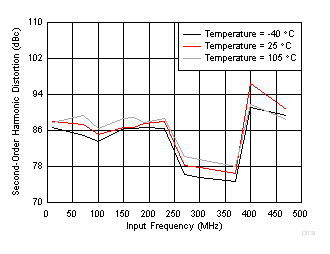
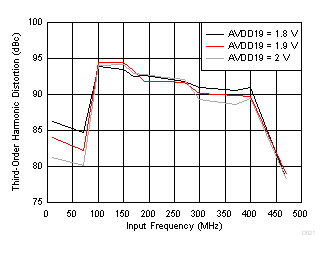
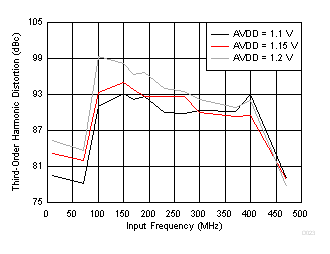
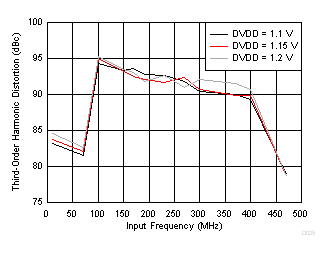
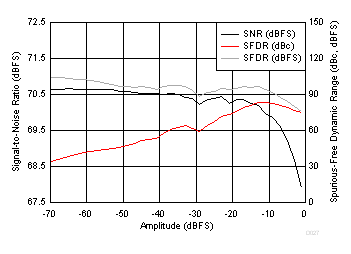
| fIN = 370 MHz |
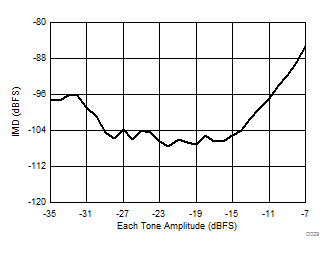
| fIN1 = 340 MHz, fIN2 = 350 MHz | ||
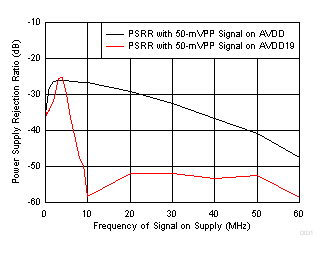
| fIN = 190 MHz, AIN = –1 dBFS, fNoise = 5 MHz, ANoise = 50 mVPP | ||
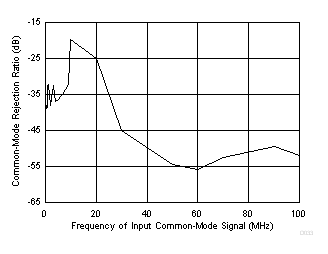
| fIN = 190 MHz, AIN = –1 dBFS, fNoise = 5 MHz, ANoise = 50 mVPP |
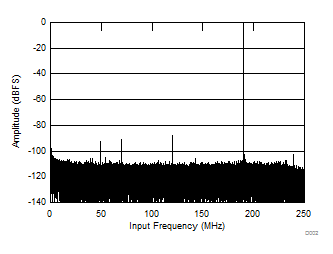
| fIN = 190 MHz, AIN = –1 dBFS, SNR = 69.23 dBFS, SFDR = 86.83 dBc, SFDR = 91.23 dBc (non 23) |
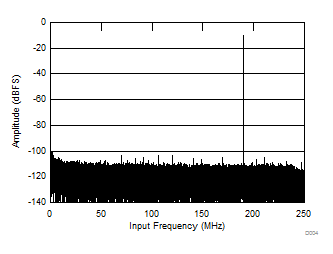
| fIN = 190 MHz, AIN = –10 dBFS, SNR = 70.05 dBFS, SFDR = 93.27 dBc, SFDR = 97.26 dBc (non 23) |
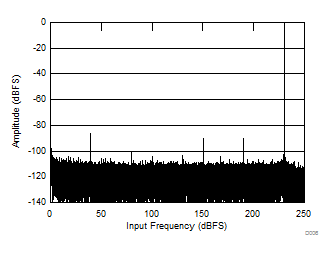
| fIN = 230 MHz, AIN = –1 dBFS, SNR = 69.17 dBFS, SFDR = 85.29 dBc, SFDR = 89.30 dBc (non 23) |
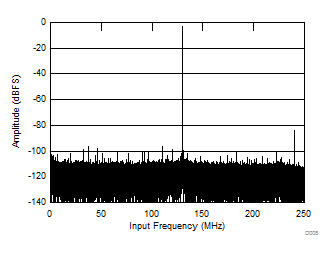
| fIN = 370 MHz, AIN = –3 dBFS, SNR = 68.36 dBFS, SFDR = 81.37 dBc, SFDR = 97.28 dBc (non 23) |
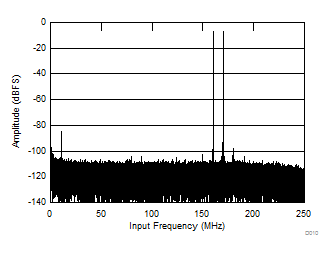
| fIN1 = 160 MHz, fIN2 = 170 MHz, IMD = 102.68 dBFS, each tone at –7 dBFS |
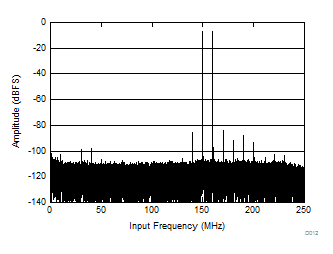
| fIN1 = 340 MHz, fIN2 = 350 MHz, IMD = 84.34 dBFS, each tone at –7 dBFS |
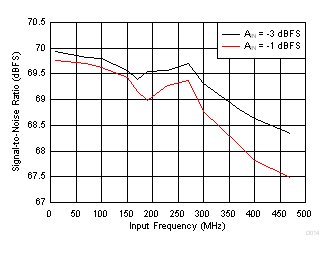
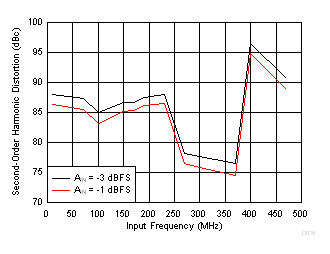
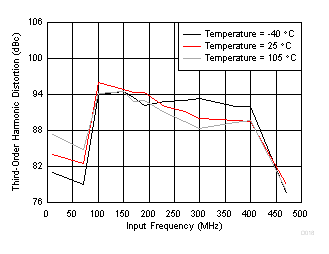
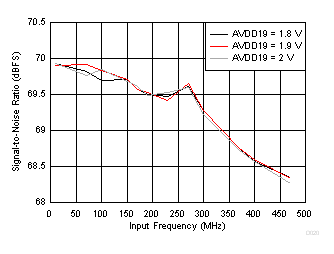
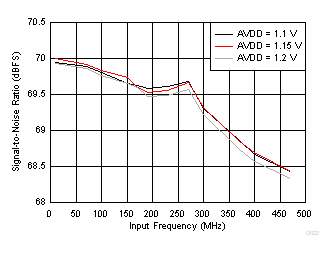
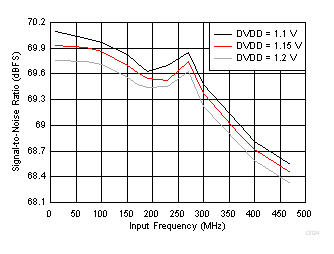
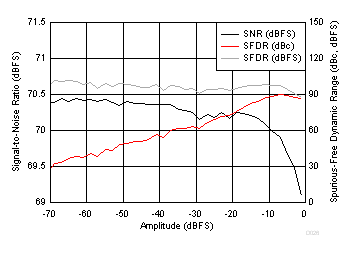
| fIN = 190 MHz |
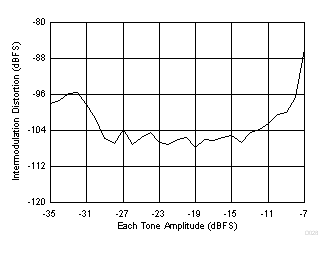
| fIN1 = 160 MHz, fIN2 = 170 MHz |
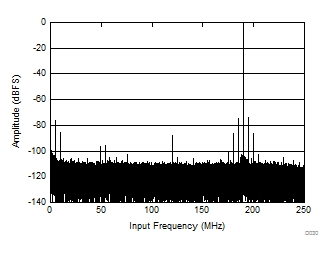
| fIN = 190 MHz, AIN = –1 dBFS, fNoise = 5 MHz, ANoise = 50 mVPP, SFDR = 73.5 dBFS |
for 50-mV Noise on AVDD Supply
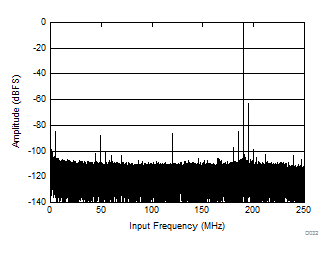
| fIN = 190 MHz, AIN = –1 dBFS, fNoise = 5 MHz, ANoise = 50 mVPP, SFDR = 63.12 dBFS |
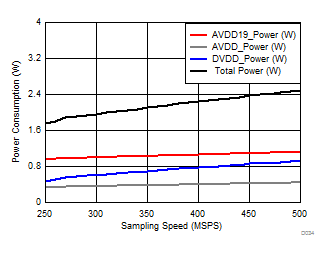
6.10 Typical Characteristics: Mode 2
typical values are at TA = 25°C, full temperature range is from TMIN = –40°C to TMAX = +100°C, device sampling frequency = 1 GSPS, 50% clock duty cycle, AVDD19 = 1.9 V, AVDD = DVDD = 1.15 V, –1-dBFS differential input, and fIN = 190 MHz (unless otherwise noted)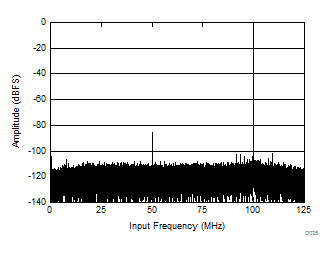
| fIN = 150 MHz, AIN= –1 dBFS, SNR = 72.85 dBFS, SFDR = 84.41 dBc, SFDR = 100.99 dBc (non 23) |
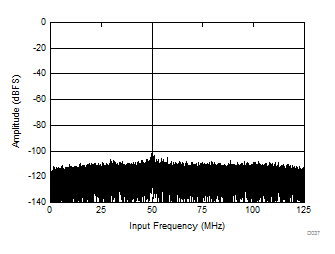
| fIN = 300 MHz, AIN= –3 dBFS, SNR = 72.3 dBFS, SFDR = 100.31 dBc, SFDR = 100.75 dBc (non 23) |
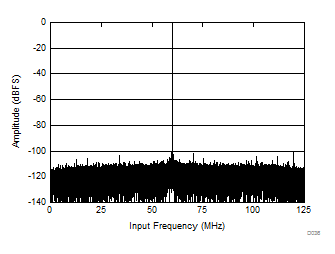
| fIN = 190 MHz, AIN= –1 dBFS, SNR = 72.37 dBFS, SFDR = 99.95 dBc, SFDR = 100.76 dBc (non 23) |
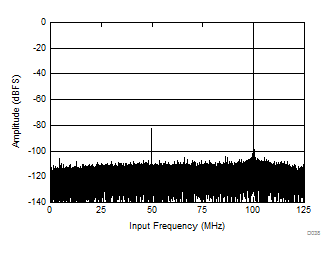
| fIN = 350 MHz, AIN= –3 dBFS, SNR = 72.02 dBFS, SFDR = 79.23 dBc, SFDR = 96.42 dBc (non 23) |
6.11 Typical Characteristics: Mode 0
typical values are at TA = 25°C, full temperature range is from TMIN = –40°C to TMAX = +100°C, device sampling frequency = 1 GSPS, 50% clock duty cycle, AVDD19 = 1.9 V, AVDD = DVDD = 1.15 V, –1-dBFS differential input, and fIN = 190 MHz (unless otherwise noted)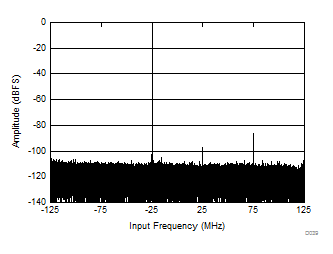
| fIN = 100 MHz, AIN= –1 dBFS, SNR = 70.16 dBFS, SFDR = 84.95 dBc, SFDR = 95.41 dBc (non 23) |
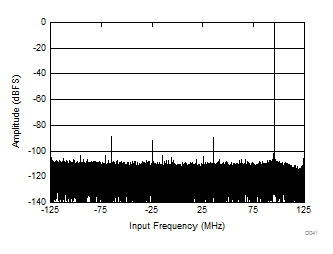
| fIN = 220 MHz, AIN= –1 dBFS, SNR = 69.27 dBFS, SFDR = 87.66 dBc, SFDR = 91.04 dBc (non 23) |
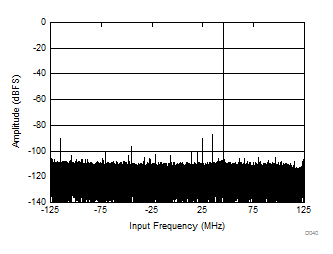
| fIN = 170 MHz, AIN= –1 dBFS, SNR = 69.35 dBFS, SFDR = 86.46 dBc, SFDR = 89.27 dBc (non 23) |
6.12 Typical Characteristics: Dual ADC Mode
typical values are at TA = 25°C, full temperature range is from TMIN = –40°C to TMAX = +100°C, device sampling frequency = 1 GSPS, 50% clock duty cycle, AVDD19 = 1.9 V, AVDD = DVDD = 1.15 V, –1-dBFS differential input, and fIN = 190 MHz (unless otherwise noted)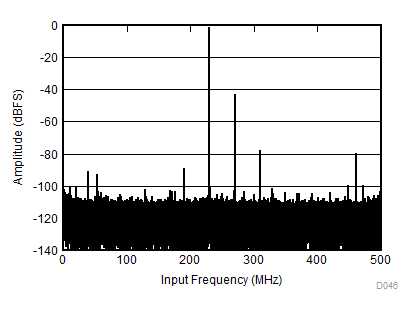
| fIN = 230 MHz, AIN= –1 dBFS, SNR = 68.11 dBFS, SFDR = 77.01 dBc, interleaving spur = –42.85 dBFS |
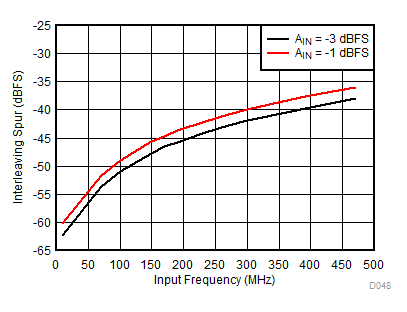
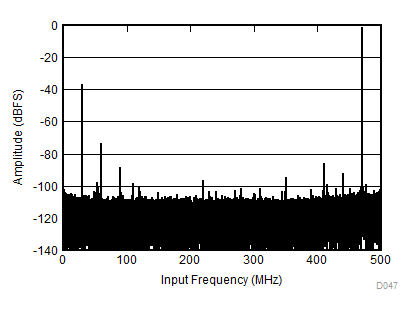
| fIN = 470 MHz, AIN= –1 dBFS, SNR = 66.56 dBFS, SFDR = 72.32 dBc, interleaving spur = –36.96 dBFS |